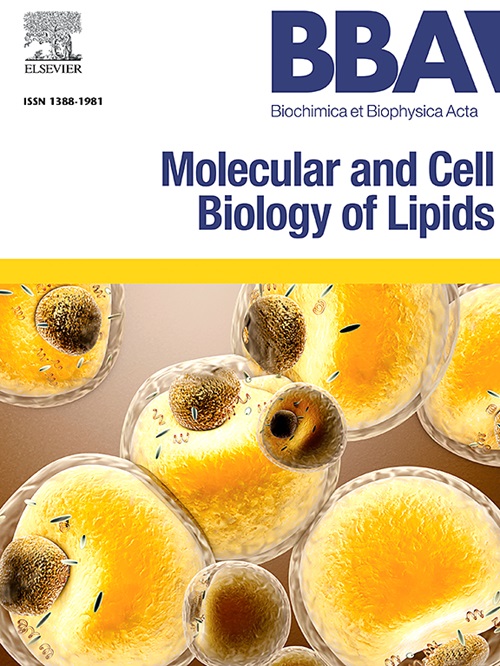Specificity mechanism of Group VIA calcium-independent phospholipase A2 toward truncated-oxidized phospholipids and its application for specific inhibitor design
IF 3.3
2区 生物学
Q2 BIOCHEMISTRY & MOLECULAR BIOLOGY
Biochimica et biophysica acta. Molecular and cell biology of lipids
Pub Date : 2025-06-29
DOI:10.1016/j.bbalip.2025.159655
引用次数: 0
Abstract
Phospholipase A2 (PLA2) constitutes a superfamily of enzymes that hydrolyze the sn-2 fatty acyl chain of glycerophospholipids. Polyunsaturated fatty acids (PUFAs) are preferentially attached at the sn-2 position of glycerophospholipids and are easily truncated by oxidation. The truncated-oxidized phospholipids (tr-oxPLs) trigger various cellular responses, and PLA2s may play a critical role in the metabolism of the tr-oxPLs by removing the oxidized sn-2 chain. In the present study, we demonstrated using an in vitro lipidomics assay that Group VIA calcium-independent PLA2 (GVIA iPLA2) showed high activity toward phosphatidylcholine with a 9-oxononanoyl chain, but not with an azelaoyl chain on the sn-2 position. We conducted molecular dynamics simulations which revealed that the hydrophilicity of the sn-2 acyl chain critically affects the binding of the substrate in the active site. Based on the unique specificity of GVIA iPLA2 toward tr-oxPLs, we synthesized an oxidatively modified inhibitor (GK766) for GVIA iPLA2, aiming for improvement of its selectivity and/or potency. As we expected, the modified inhibitor improved its selectivity of GVIA iPLA2 compared to the unmodified inhibitor (GK187), although the inhibitory effect became somewhat weaker. More importantly, we demonstrated that GK766 induces cell death by ferroptosis more effectively than GK187 using an erythroleukemia cell line. In the present study, we have further defined the unique substrate specificity of GVIA iPLA2 toward tr-oxPLs and its molecular mechanism. Furthermore, we have developed a novel specificity-based inhibitor that induces ferroptosis demonstrating that using substrate selectivity helps in developing more effective therapeutics.
VIA组钙非依赖性磷脂酶A2对截断氧化磷脂的特异性机制及其在特异性抑制剂设计中的应用。
磷脂酶A2 (PLA2)是一个水解甘油磷脂sn-2脂肪酸酰基链的超家族酶。多不饱和脂肪酸(PUFAs)优先附着在甘油磷脂的sn-2位置,容易被氧化截断。截断的氧化磷脂(tr-oxPLs)引发各种细胞反应,PLA2s可能通过去除氧化的sn-2链在tr-oxPLs的代谢中发挥关键作用。在本研究中,我们通过体外脂质组学分析证明了VIA组钙非依赖性PLA2 (GVIA iPLA2)对含有9-氧壬烷基链的磷脂酰胆碱具有较高的活性,而对sn-2位置上的氮杂二烷基链则没有活性。我们进行了分子动力学模拟,结果表明sn-2酰基链的亲水性严重影响底物在活性位点的结合。基于GVIA iPLA2对tro - oxpls的独特特异性,我们合成了GVIA iPLA2的氧化修饰抑制剂(GK766),旨在提高其选择性和效价。正如我们所料,与未修饰的抑制剂(GK187)相比,修饰后的抑制剂提高了GVIA iPLA2的选择性,尽管抑制作用有所减弱。更重要的是,我们利用红白血病细胞系证明GK766比GK187更有效地诱导铁凋亡细胞死亡。在本研究中,我们进一步明确了GVIA iPLA2对tro - oxpls独特的底物特异性及其分子机制。此外,我们已经开发出一种新的特异性抑制剂,诱导铁下垂,表明使用底物选择性有助于开发更有效的治疗方法。
本文章由计算机程序翻译,如有差异,请以英文原文为准。
求助全文
约1分钟内获得全文
求助全文
来源期刊
CiteScore
11.00
自引率
2.10%
发文量
109
审稿时长
53 days
期刊介绍:
BBA Molecular and Cell Biology of Lipids publishes papers on original research dealing with novel aspects of molecular genetics related to the lipidome, the biosynthesis of lipids, the role of lipids in cells and whole organisms, the regulation of lipid metabolism and function, and lipidomics in all organisms. Manuscripts should significantly advance the understanding of the molecular mechanisms underlying biological processes in which lipids are involved. Papers detailing novel methodology must report significant biochemical, molecular, or functional insight in the area of lipids.

 求助内容:
求助内容: 应助结果提醒方式:
应助结果提醒方式:


